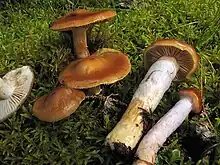| Cortinarius collinitus | |
|---|---|
 | |
| Scientific classification | |
| Domain: | Eukaryota |
| Kingdom: | Fungi |
| Division: | Basidiomycota |
| Class: | Agaricomycetes |
| Order: | Agaricales |
| Family: | Cortinariaceae |
| Genus: | Cortinarius |
| Species: | C. collinitus |
| Binomial name | |
| Cortinarius collinitus | |
| Cortinarius collinitus | |
|---|---|
| Gills on hymenium | |
| Cap is convex or flat | |
| Hymenium is adnexed | |
| Stipe has a cortina | |
| Spore print is reddish-brown | |
| Ecology is mycorrhizal | |
| Edibility is inedible | |
Cortinarius collinitus, commonly known as the belted slimy cortinarius,[1] is a species of fungus in the family Cortinariaceae.
Description
The cap is 3–9 cm in diameter, convex to flat in shape, with a sticky, gelatinous surface (in moist conditions). The gills are adnexed, close, and pallid or pale violet in color. The stipe is typically 6–12 cm long and 1–1.5 cm thick, solid, equal, and has transverse scaly-looking bands. The spore print, like most Cortiniarius species, is rusty-brown. The edibility for this species was unknown,[2] but it is now considered inedible.[3]
See also
References
- ↑ Arora, David (1986). Mushrooms demystified: a comprehensive guide to the fleshy fungi (Second ed.). Berkeley: Ten Speed Press. p. 431. ISBN 978-0-89815-169-5.
- ↑ Orr, R.T., Orr, D.B. (1979). Mushrooms of Western North America. University of California Press: Berkeley. pg. 168.
- ↑ Phillips, Roger (2010). Mushrooms and Other Fungi of North America. Buffalo, NY: Firefly Books. p. 160. ISBN 978-1-55407-651-2.
External links
- Medicinal Mushrooms description and medicinal properties
- Roger's Mushrooms description
This article is issued from Wikipedia. The text is licensed under Creative Commons - Attribution - Sharealike. Additional terms may apply for the media files.